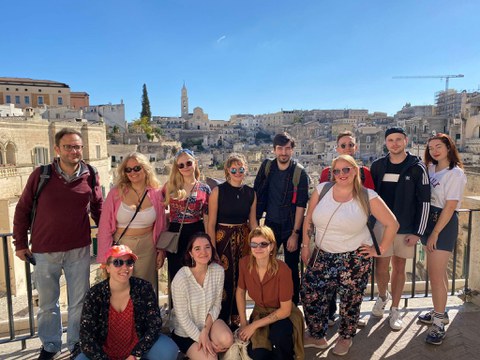Report on the Apulia 2022 excursion
From 3 to 7 October 2022, nine students from various degree programs in the School of Humanities and Social Sciences and three teachers from the Institute of Romance Studies travelled to Bari in the southern Italian region of Puglia, the home of embassy lecturer Valentina Cuomo, who initiated and organized this excursion.
Puglia is known above all for its miles of coastline on the Mediterranean, the hilltop villages with their whitewashed houses and for centuries of agriculture, especially the cultivation of olives and almonds. Water is a special commodity in the rather dry hinterland, the Murgia, so it has always been necessary to collect rainwater and channel it into cisterns, some of which are underground. The reference to water and the sea is also repeatedly encountered symbolically in art and culture. Thanks to an Italian city guide, who accompanied the excursion for four days and enriched it with personal contacts to locals, the opportunity arose to immerse oneself completely in the Italian culture and language of Apulia. The excursion's supporting program therefore included not only guided tours of the city, but also an exploration of the local cuisine, including a visit to an olive plantation with olive oil tasting. By hiring a minibus, the excursion group was able to explore the surrounding towns individually from the city of Bari.
A particular highlight was the visit to Castel del Monte, which dates back to the time of the Hohenstaufen Emperor Frederick II. The function of the castle has been puzzled over, with the octagonal ground plan inspiring fantastic ideas. The more factual interpretations range from a hunting lodge to a building for storing the state treasury. However, the castle was probably never completed. The European Capital of Culture Matera was to be the highlight of the excursion. In the cylindrical old town in the middle of the hills, ancient stone houses have been built, some of them into the elevations of the landscape. These cave settlements of the grotto city, the "Sassi di Matera", are a UNESCO World Heritage Site. While exploring the town, we were able to watch a local potter making a cucù, the typical Matera clay pipe in the shape of a cockerel, and sample Apulian specialties. The town of Trani, the municipality of Ostuni with its whitewashed houses, the circular municipality of Locorotondo and the town of Alberobello, famous for its trulli - white one-room houses with conical roofs made of natural stone - also enchanted visitors with their charm.
A big thank you goes to the Society of Friends and Supporters of TU Dresden e.V. and the Faculty of Linguistics, Literature and Cultural Studies at TU Dresden, whose financial support made this interesting and enjoyable excursion possible.
Johanna Döring

